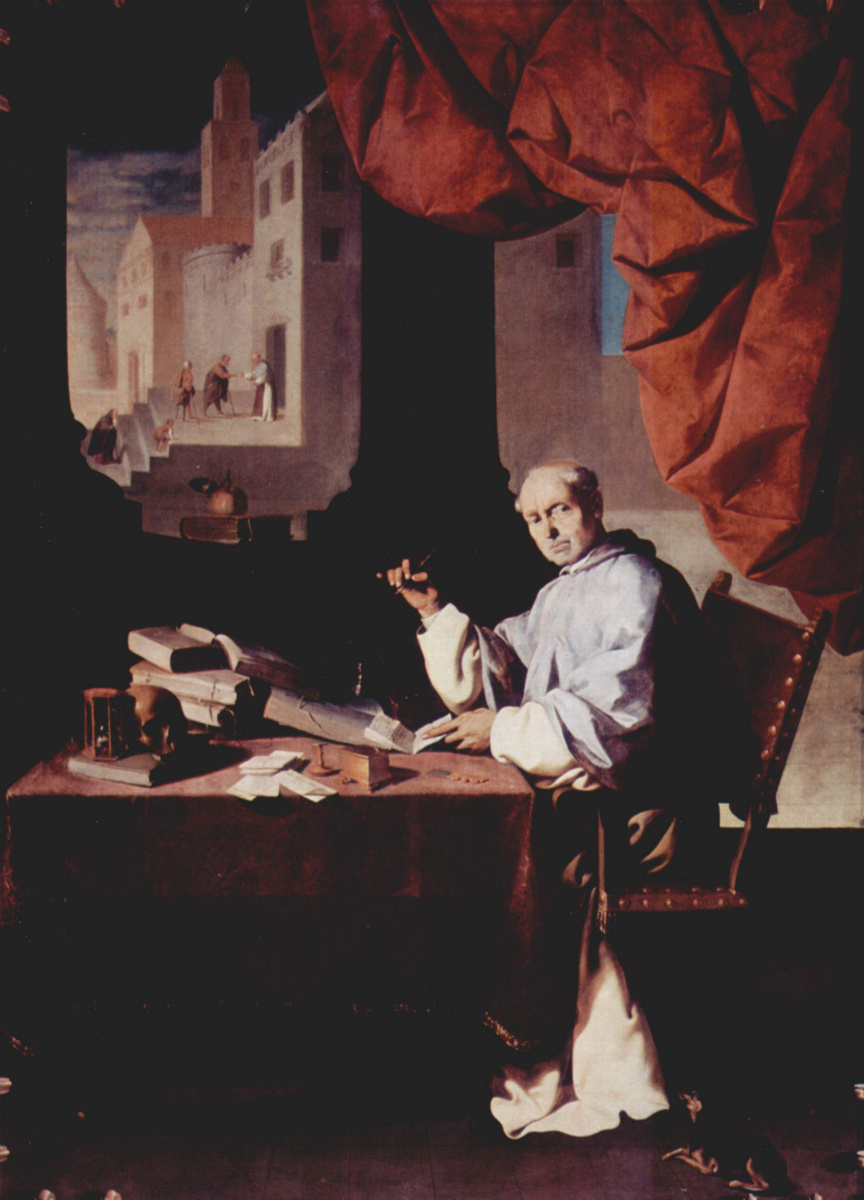log in
Enter site
Login to use Arthive functionality to the maximum
Portrait of brother Gonzalo de Illescas
Francisco de Zurbaran • Painting, 1639, 290×222 cm
Description of the artwork «Portrait of brother Gonzalo de Illescas»
"Portrait of brother Gonzalo de Illescas" part of a large series of paintings commissioned from Zurbaran in 1638-1639 year for sacristy and chapel of the monastery of our lady (Nuestra Señora) of Guadalupe, a town in the Spanish region of Extremadura, from where the artist was born. Thanks to a happy coincidence, these works of Zurbaran and are now in the place for which it was created. Experts believe it is a rare luck, because the full pattern perception is extremely important architectural context in which it is inscribed.
Gonzalo de Illescas was a monk of the congregation of St. Jerome, a theologian and one of the most educated people of the fifteenth century. The pensive expression of his beautiful, significant face shows that Gonzalo "caught" by the artist in the moment of hard work on another theological essay.
Zurbaran quite a long time was evaluated by art historians prejudice: to the XVIII century it was considered not to be more than an imitator Caravaggiolater talked about his provincialism. Even go was scathing definition of "ignorant genius", implying that Zurbaran did not know the history of painting and didn't understand current trends. Paintings of the late 1630s years, including a portrait of his brother Gonzalo de Illescas, refute such accusations. Note that there is clearly traced the influence of the predecessor El Greco(architectural landscape with the charity behind the pillar in the background) and contemporary Velasquez(under the influence of his work figure Zurbaran becomes softer, it leaves sculpture sharpness, and frontal illumination is replaced by the light falling from behind). Massive purple drape refers to the Italian painting; the masterly and a still life of books, an hourglass, a bell and inkwell to the Flemish.
Many items on the canvas belong to the favorite explanation of Zurbaran, repeated with variations from painting to painting. Among them – the skull, the monastic attribute, reminiscent of the vanity of earthly existence, and the massive column of dark (like we can see in "The Apotheosis Of Thomas Aquinas"and "The Circumcision Of The Lord"). Its symbolic meaning is clear: the column connects the high and Dalnee, matches the earthly and heavenly plans. Another allegorical detail – Apple, put on top of the book at the border of the first and second plans. Apple is traditionally the symbol of temptation, knowledge from the tree of good and evil. The book (obviously the Bible) must point to the sinfulness and finiteness of the futility of knowledge, not backed by faith.
Author: Anna Yesterday
Gonzalo de Illescas was a monk of the congregation of St. Jerome, a theologian and one of the most educated people of the fifteenth century. The pensive expression of his beautiful, significant face shows that Gonzalo "caught" by the artist in the moment of hard work on another theological essay.
Zurbaran quite a long time was evaluated by art historians prejudice: to the XVIII century it was considered not to be more than an imitator Caravaggiolater talked about his provincialism. Even go was scathing definition of "ignorant genius", implying that Zurbaran did not know the history of painting and didn't understand current trends. Paintings of the late 1630s years, including a portrait of his brother Gonzalo de Illescas, refute such accusations. Note that there is clearly traced the influence of the predecessor El Greco(architectural landscape with the charity behind the pillar in the background) and contemporary Velasquez(under the influence of his work figure Zurbaran becomes softer, it leaves sculpture sharpness, and frontal illumination is replaced by the light falling from behind). Massive purple drape refers to the Italian painting; the masterly and a still life of books, an hourglass, a bell and inkwell to the Flemish.
Many items on the canvas belong to the favorite explanation of Zurbaran, repeated with variations from painting to painting. Among them – the skull, the monastic attribute, reminiscent of the vanity of earthly existence, and the massive column of dark (like we can see in "The Apotheosis Of Thomas Aquinas"and "The Circumcision Of The Lord"). Its symbolic meaning is clear: the column connects the high and Dalnee, matches the earthly and heavenly plans. Another allegorical detail – Apple, put on top of the book at the border of the first and second plans. Apple is traditionally the symbol of temptation, knowledge from the tree of good and evil. The book (obviously the Bible) must point to the sinfulness and finiteness of the futility of knowledge, not backed by faith.
Author: Anna Yesterday


